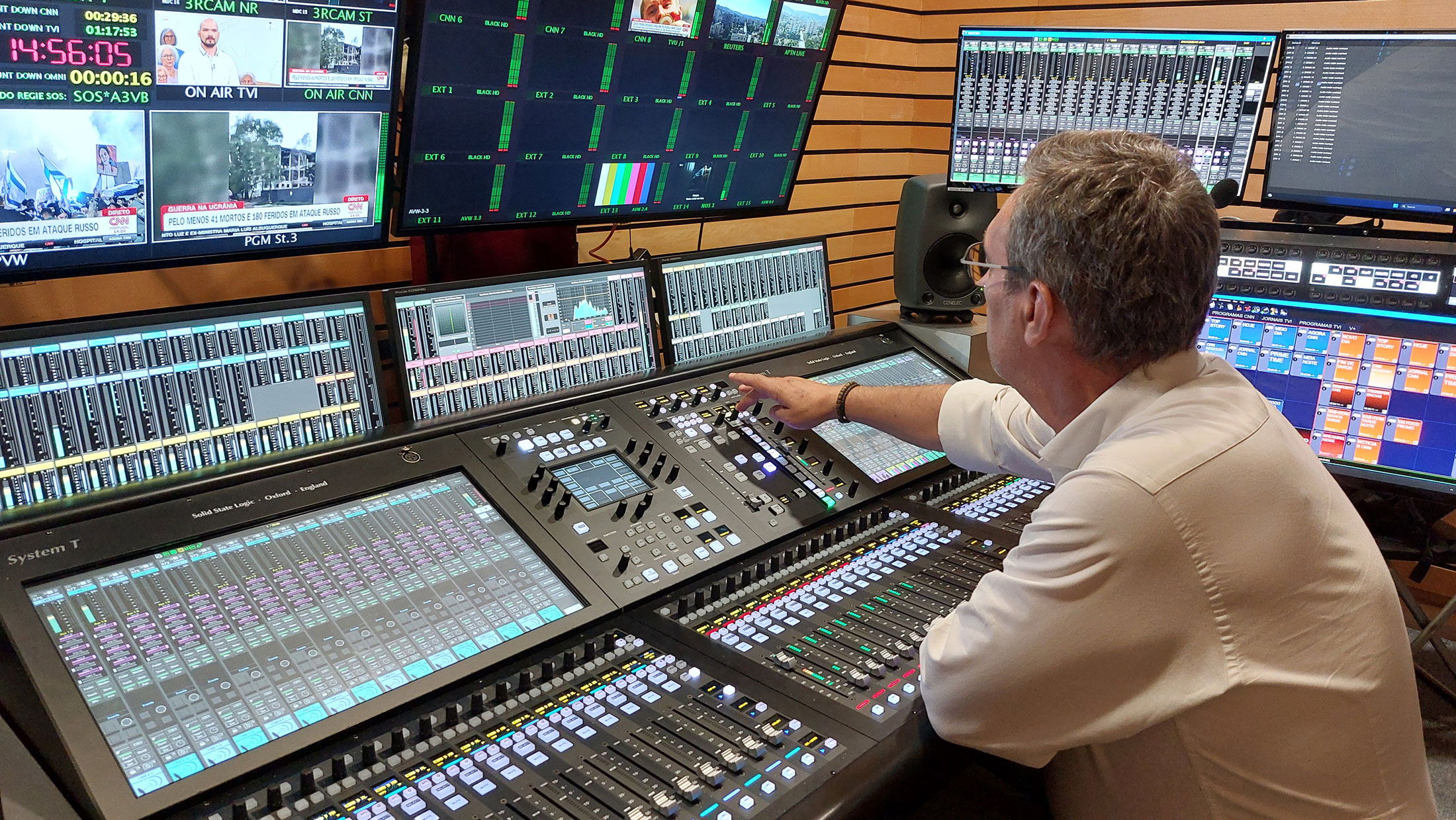Portugal's TVI Anchors its Multi-Studio Broadcast Facility on Solid State Logic System T Production Platform, Including S500 Mixing Console, Tempest Control App, and TE2 Tempest DSP Engines
System T’s market-leading AoIP integration and distributed architecture enable TVI to operate across any of its existing studios, with plenty of opportunity for expansion
Lisbon, Portugal, October 17, 2024 — Portuguese broadcaster TVI (Televisão Independente) has installed a Solid State Logic System T broadcast platform to augment the operational flexibility of its multi-studio facility in Lisbon. The new system, comprising an S500 mixing console with redundant TE2 Tempest Engines and various Network I/O interfaces, has been integrated into the TVI production facility’s IP architecture, enabling it to operate with any of the plant’s existing studios. Multiple instances of SSL’s Tempest Control App (TCA) provide additional control options for audio operators or TVI’s engineering team.
“System T was one of the few systems in the market that matched our demands in terms of sound quality, usability and redundancy,” says Ricardo Lima, Architecture & New Projects, Broadcast IT at the Technology Directorate for Media Capital, TVI’s owner. “To accomplish a well-organized, expandable and efficient audio network around our facility the choice had to be IP-driven for the audio, and the software components had to be easy to use and quickly deployable in CoTS hardware or virtual machines. System T’s deep integration with Dante was a key factor in accommodating the various sources and destinations in the studios, control rooms, newsrooms and post-production studios.”

Networked efficiency and redundancy
System integrator Dec.Imagen, SSL’s preferred integrator in Portugal led by Director General José Rafael Adegas, supplied the System T platform. The equipment complement includes a modular 3.5-bay S500 console with dual TE2 DSP engines. Three Network I/O SB 8.8 SuperAnalogue™ mic/line stage boxes plus a single A16.D16 SuperAnalogue/AES3 unit to interface with the Dante network, and a Fader Tile, providing familiar hardware controls for the TCA positions. A pair of Network I/O D64 AES-to-Dante interfaces and an HC Bridge SRC high-capacity AoIP interface also integrate System T with the facility's ST 2110 infrastructure and existing equipment.
One of the platform’s highlights is System T’s ease of use, Lima reports: “Audio operators quickly understand the concepts and can perform some very important configurations that usually are only available at the engineering level, such as the creation or modification of events — GPIOs, MIDI integration and button or fader actions — that are crucial to configuration scenarios such as ours. Also, the elasticity of the Tempest Engines allows us to allocate audio paths and processing resources dynamically, in real-time. Further, TE2 processors can be software licensed temporarily to give us up to 800 available DSP audio paths when we need it.”

Broadcast-centric features, stellar audio quality
TVI’s audio engineers appreciate System T’s broadcast-oriented features, overall ease of use and sound quality, he also comments. “The seamless transition between audio engines — main and backup — and a backup TCA on the side, are some of the features most valued by audio engineers, offering them robust and trustworthy redundancies to steer their concentration away from potential problems.”
The System T console, associated interfaces and control elements are installed in a new audio control room that is very similar to the broadcaster’s existing facilities in terms of equipment placement and layout. “Despite the fact that the technology and capabilities of this new control room are unmatched,” Lima says, “in terms of layout, the intention was to give the audio engineers a sense of familiarity for a more efficient and productive environment.”
Ultimate flexibility in a multi-room scenario
The great majority of audio sources in the plant are always present on the Dante network and ready to be mixed. “Our S500 targets its own embedders, so the SSL system can create an independent production and work standalone or side by side with our current control rooms,” Lima elaborates. When operating another control room, “There are specific destinations that need to be replaced from their current sources to the System T in that case, and broadcast control system is used to manage connections to other control rooms,” he says.
Two instances of TCA are present on the network. One is running on a hardware PC with a touchscreen monitor in the new audio control room. It can be used, for example, as an extension of the S500 itself, to provide an additional operator position, additional metering displays or to manage the built-in FX Rack, scene automation or setup functionality. A second TCA instance is available on a virtual machine in high availability mode, that may be accessed anywhere in the facility or even remotely. This provides a permanently available redundant control position that can be instantly switched to, with the same processing feature-set and showfile compatibility as the S500, whilst targeting the same redundant pair of Tempest Engines.

About Solid State Logic
Solid State Logic is the world’s leading manufacturer of analogue and digital audio consoles and provider of creative tools for music, broadcast, live and post production professionals. For more information about our award-winning products, please visit: www.solidstatelogic.com.
Jeff Touzeau
2408_SSL_TVI_FFF.docx
DOCX 41 KB





